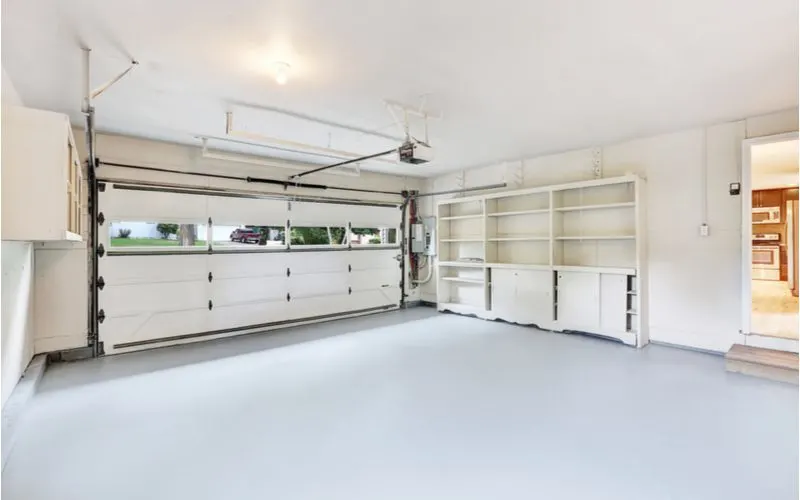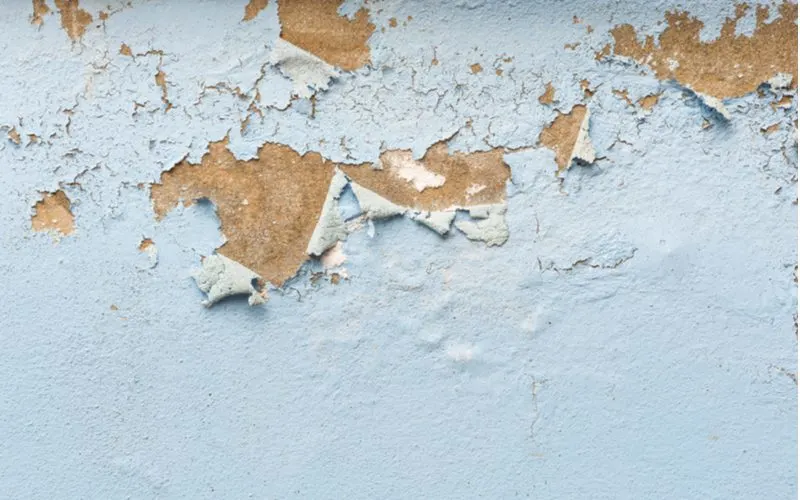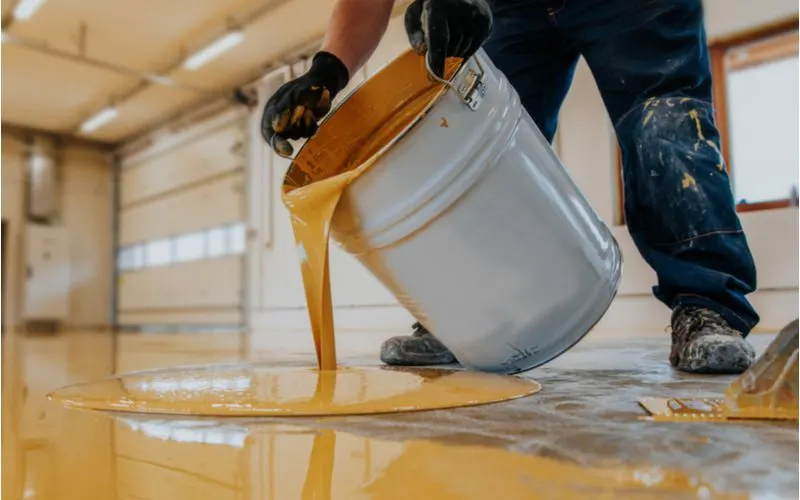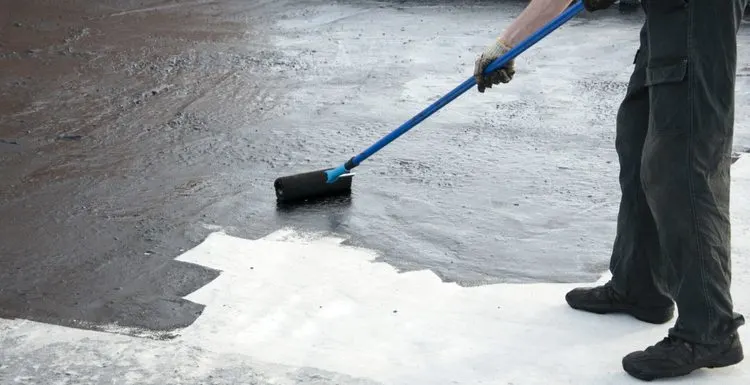The floor is the best place to start when it comes to updating the look of your home.
While your old flooring may have been functional, painting your floors can transform and improve both comfort and aesthetics.
Ordinary paint will wear and peel off after only a few months, but concrete paint can last for years. It can also reinvigorate surfaces and withstand a lot of abuse.
The Benefits of Concrete Paint

Artazum/Shutterstock
Many homeowners overlook the various health benefits associated with painted concrete floors.
If someone in your home suffers from allergies, ripping up your carpets and painting the concrete may provide symptom relief and increase the overall quality of your air.
This is a huge benefit to those with respiratory infections. Painted concrete floors can also be cleaned in a more practical and sanitary way.
As an example, hospitals with painted concrete floors have reported up to 78 percent reductions in parasitic infections in children.
Unlike flooring composed of natural fibers, mold and mildew cannot thrive on floors covered with concrete paint. Painted concrete floors are also very pet-friendly.
Homeowners with indoor pets quickly realize that painted and sealed concrete repels rather than traps pet dander.
Added Curb Appeal
A garage isn’t always an aesthetically pleasing part of a house.
Painting a garage or patio floor is an inexpensive way to boost a home’s value. You can add style and versatility to any concrete floor with just a splash of creativity.
After painting, consider adding a colorful border or applying a stencil over the top of the first layer of concrete paint. Adding freehand designs adds a bit of whimsy to any space.
But careful consideration should be given before adding a design. The wrong color or pattern can make a room feel smaller and darker.
Use the same principles for concrete paint that you would in choosing carpet for a particular space. Think about the size of the room and the natural light.
Also, consider what color or style will help to hide dirt and messes. Choose a pattern and color that is simple and easy to maintain.
How to Use Concrete Paint in 6 Steps
Proper surface preparation is essential to achieving satisfying results with concrete paint.
1. Repair Damaged Areas With a Filling Compound
As its name suggests, a cement filler patches scratches, gouges, and holes in the concrete.
After the mixture has been applied and has had adequate time to dry, the area will require sanding. When the site is completely smooth, you’re ready to continue to the next step.
2. Use TSP to Clean the Concrete
Combine TSP and warm water by following the package instructions.
Use a metal-bristle brush to remove the oil and grease on the concrete surface. If this step isn’t completed correctly, it may discolor the paint.
3. Allow the Surface to Dry
This part of the process may take up to two days, as you want to ensure that all of the TSP has been washed away and the concrete is thoroughly dried.
After drying, it should feel rough, like 120-grit sandpaper. Sweep and wipe off the entire surface so that no dirt or dust remains.
4. Apply Paint
Use a paintbrush to apply paint over the entire perimeter, filling in the corners and edges. Remember to paint both interior and exterior spaces. Next, cover the remaining portion of the space with a paint roller.
When painting a floor, always begin on the far side of the room, leaving yourself a way to exit. The first coat of paint will need around 24 hours to dry.
5. Remove Surface Imperfections
Use a putty knife to scrape away any bumps that have appeared after the first coat has dried. Sand the areas where the paint failed to adhere to the surface. It’s important to remember to sweep after sanding or scraping.
6. Apply a Second Coat
Apply a second coat of concrete paint in the same way as the first coat. This time, press down firmly on the roller to ensure that every hole and crevice has been filled.
It’ll take five or more days for this coat of paint to dry, especially in a heavily trafficked area.
Patios and garages have the advantage of drying in the open air. Indoor spaces are a little trickier.
Even opening a window or running an air conditioner won’t provide fast enough drying results. Powerful fans help to dry concrete paint much quicker.
Pros and Cons of Concrete Paint

Artazum/Shutterstock
Pros (What We Like)
- Long-lasting. Concrete paint provides a durable finish ideal for garage floors, patios, walls, sidewalks, and more.
- Weather-resistant. Most concrete paint is meant for exterior use and is water-resistant. However, they are not waterproof. Over time, this paint will wear down unless a rubber coating has been applied.
- Offers good coverage. Concrete delivers excellent coverage, especially after filling small to large holes and cracks with liquid cement. When the paint is applied with a roller, it fills the porous concrete and produces a finished and complete look.
- Wide variety of colors. Until recently, concrete paint was only available in a limited number of colors. Now, many paint companies offer vibrant colors that are guaranteed to stay bright over time.
- Hides faults in concrete floors. Concrete paint covers, protects, and hides flaws in concrete floors. Keep in mind that if the sealer isn’t applied soon after painting, some of the imperfections in the concrete may reappear.
Cons (What We Don’t Like)

Wuttichok Panichiwarapun/Shutterstock
- Slippery when wet. It’s essential to protect you and your guests from getting hurt by preventing your wet concrete floor from causing slips.
- After painting the floor, you can avoid this issue by adding a layer of silica sand or non-slip concrete sealer. If the foundation has been previously sealed, non-slip strips can be added on top of the floor.
- Vulnerable to abrasion. The truth is that the more wear and tear concrete paint experiences, the shorter its lifespan will be. Consider the difference between an industrial workplace and a home garage. Floors will require more frequent painting if they have a lot of foot traffic and impact from other substances.
- May require professional work. Do-it-yourself projects aren’t for everyone. Painting concrete floors may require a professional.
- It’s not cheap. However, if you are not confident that you can do a quality job the first time, hiring a professional is your best option so that you don’t have to pay them to fix any mistakes you might have made.
- Bleeding through can ruin a newly painted floor. Even paint made especially for concrete floors might not keep rust, oil, and spots from bleeding through. These things and more can lead to paint discoloration and chipping.
Frequently Asked Questions

faithie/Shutterstock
Will concrete paint stick to surfaces?
Concrete paint won’t stick to a concrete surface unless it has been sanded or etched beforehand.
It requires a porous surface to serve as a primer that allows the paint to adhere. One way to prepare the concrete for painting is to use a solution of phosphoric or muriatic acid.
These acids are available at home improvement and paint stores. Because these acids can be dangerous, wear a pair of goggles, rubber gloves, a respirator, and protective clothing before applying the chemicals to the flow. Remove the acid from the floor before going to the next step.
Combine a solution of baking soda with water to neutralize the acid. Spread it over the floor and wash the surface with water.
After the acid is applied, it’ll create microscopic depressions on the surface. This process is called etching. Now, the concrete paint will better stick to the floor.
Does concrete paint require a sealer?
Most concrete paint brands suggest that you add a new coat of paint every 3–5 years.
A concrete sealer applied over concrete paint will last between 5 and 10 years, making sealer a good investment. Apply a concrete sealer to add an extra layer of protection to painted concrete floors.
While it isn’t necessary, it’ll keep the floor from getting scratches, peeling, or wearing off. Concrete sealants come in matte and glossy finishes.
It’s applied the same way concrete paint is affixed to the floor: first, with a brush around the edges and corners, and then with a roller to cover the remaining surface area. Unlike concrete paint, sealer dries quickly, taking less than 24 hours.
Are floors with concrete paint easy to clean?
Typical messes on high-traffic, concrete-painted floors can be cleaned up quickly and efficiently.
What are some practical tips for cleaning an unsealed, painted concrete floor?
- Clean the floor regularly. If you maintain the cleanliness of your floor before any problems become severe, your concrete paint will last much longer.
- Target stains before they become permanent. The longer a stain remains on the floor, the more it’ll soak into the concrete. They can be partially removed with hard work, but it may be impossible for them to be eliminated.
- A great way to soak up grease and oil that may have collected on a floor is to sprinkle sawdust and cat litter over these spots. These substances will absorb a large portion of the oil overnight. Use a push broom or wet-dry vacuum to eliminate the debris.
- After cleaning, always use a wet dust mop to get rid of any leftover dirt or dust.
- Sprinkle dishwasher detergent on hard to remove floor stains. If the stain has dried, wet it, and then allow the detergent to soak into the stain for at least 30–45 minutes.
Next, pour boiling water over the detergent and scrub with a stiff brush until most of the stain has been removed.
Rinse with clear water until the residue is gone. Adding a sealer over concrete paint will make it easy to sweep up dirt and dust.
Water will sit on top of the floor rather than absorb it. Clean your painted concrete surfaces once a week, and you will save time and money.
How do you add texture to a floor with concrete paint?
Paint texture additives can be combined with concrete paint to create decorative and slip-resistant qualities.
There is a variety of additives, such as sand, stone, and colored chips and flecks. Textured floor paint can offer anti-slip properties in places where water is likely to collect, such as bathrooms, kitchens, and patios.
Decorative concrete paint can be applied to various surfaces to change the look and feel of a space. While this isn’t particularly expensive, it can make an impressive impact on any room inside or outside a home.
Should You Use Concrete Paint?

Doralin Samuel Tunas/Shutterstock
A dull gray concrete slab can appear to be cold and unappealing. Fortunately, it’s a versatile material that offers many options.
Concrete paint looks great on any floor in your home, including the basement, living room, balcony, kitchen, and more.
You can decorate your floor to create the desired look, one paint layer at a time. When you want to change the look of your space, simply cover over or remove the present concrete paint and create something new in its place.
There’s no need for using concrete paint to be an overwhelming process. It’s much easier than you think.
If you find that you need a little help, a professional painter can get the job done. Pay special attention when preparing and cleaning before applying concrete paint.
Be creative and take a look at the recent trends in concrete paint. The result will be a surface that adds life and freshness to your home. Concrete paint is the solution you’ve been looking for to liven up your space.

